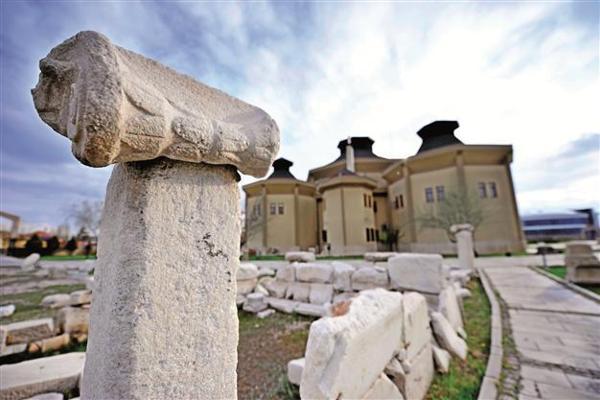Aksaray Museum home to Cappadocia history
AKSARAY – Anadolu Agency


The Aksaray Museum, covering an area of 12,000 square meters, has been reorganized and recently opened to visits. AA photos
Significant archaeological and ethnographic works that shed light on the history of Cappadocia region, mummies and the world’s first known skull to have been operated on are housed at the Aksaray Museum. The museum was recently reopened after preparation work ongoing since 2012.The museum covered an area of 12,000 square meters, 2,000 square meters of which is closed. “Constructed on an octagonal plan, the three-storey museum and its garden is home to 15,437 pieces.
There are also six halls, five storage rooms, conference halls and workrooms,” the museum’s deputy director, Fariz Demir, said, adding that the museum had been closed at the beginning of 2012 and works had been completed this year.
Ancient works at six display rooms
Six display rooms of the museum are connected to each other through corridors.
“The first room displays animal fossils, including a mammoth fossil, from Aksaray’s various geological eras, as well as various earth and rock samples. Works unearthed during scientific excavations in the Aşıklı tumulus, where the first settlement started 11,000 years ago in Cappadocia are on display in this room. The skull here shows that the world’s oldest skull operation was performed in Aşıklı tumulus. The showcases feature life in the tumulus and the tools used by people,” Demir said.
He added that it this room is followed chronologically by Musular and Güvercinkayası. “The second room shows works from Musular, which is a Neolithic Age settlement, and the ones from Güvercinkayası excavations, which was a Chalcolithic settlement in a later era,” he said.
In the third room in the museum, works unearthed during scientific excavations in Acemhöyük, one of the most important centers of Assyrian trade colonies in Anatolia, are displayed. “The fourth room displays works from the Iron Age, Hellenistic Age, Roman, Eastern Roman and Seljuk eras,” Demir added.
The fifth room is set aside as the “mummies room.” “Mummies unearthed in Aksaray and tools used in daily life that were unearthed next to mummies such as beads, necklace pieces, embroidered linen clothes, jewels from the Eastern Roman period and candles are being displayed in this room. The modern era ethnography display is in the room in the second floor. Carpet business, basketry, pottery and stone dressing are animated in this room, too,” Demir said.
He stressed that Cappadocia’s history stretching back 11,000 years was being exhibited in the museum’s six rooms and garden.
“Aksaray Museum shows people the history of Cappadocia with works in display rooms and the ones from the Roman, Byzantine and Islamic eras in the garden. With the animations, visitors to the museum have a chance to meet the civilizations that once existed in the region. We think the museum will get great interest, since the works here cannot be found anywhere else,” Demir said.
